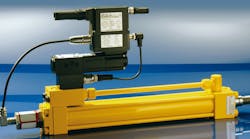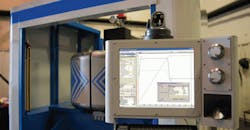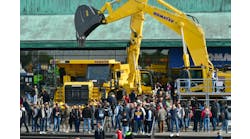I have been doing hydraulic motion control projects for 35 years. During that time, I have seen pundits predict the imminent demise of the hydraulic industry. So why hasn’t it happened? The answer is simple. Advances in hydraulic technology and training have allowed the inherent benefits of hydraulics versus other means of powering machines and mobile equipment to be demonstrated in real applications.
Two decades ago I was sitting in front of a major hydraulic company’s vice president of valves. The vice president didn’t seem to be all that interested in servo control because it was less than 5% of his company’s total business. He also deemed servo control as a little risky. Some people might have been discouraged about that, but it was obvious an opportunity existed to increase that percentage by replacing traditional on-off hydraulic valves with computer-controlled hydraulics.
Need for Better Control
The opportunity seemed clear. In essence, replace old open-loop “bang-bang” systems with hydraulic servo controls that could execute all the commands a servo motor controller could and move with the same precision. This was a lofty goal because feedback from magnetostrictive displacement transducers (MDTs) in the mid-1990s provided only about 0.001-in. resolution. Servomotors using encoders could achieve better than 0.001-in. resolution. However, hydraulic servo controllers now can use the same feedback devices as servo motors can. The playing field has been leveled. MDTs with 1.0 µm resolution are now the norm—and if they aren’t, they should be!
Back in the 1980s, one of my first hydraulic “control” applications had to move a block of wood into position at a lumber mill. One high-speed valve and one low-speed valve were controlled by two digital outputs. The operation was simple enough:
- Open both valves for high speed.
- Turn off the high-speed valve to slow down.
- Turn off the low-speed valve just before the load hit the stop to let the machine “coast” to a stop.
- Turn the low-speed valve on to hold the load at the stop.
The feedback was an absolute rotary encoder attached to a rack-and-pinion gear drive. This worked well unless the pinion skipped on the rack, causing the encoder to become misaligned. This happened because the hydraulic system used simple on-off (bang-bang) valves.
One complaint we all have heard concerns leaking oil. This had been a problem, in large part, because hydraulic shock occurred in most systems. The drastic change in pressure from valves instantly shifting from fully closed to fully open tends to push oil past seals every time a valve shifts or a cylinder hits the end of its stroke.
Fortunately, the industry has come a long way in reducing leaks—both by introducing components less likely to leak and by increasing awareness of solutions to reduce leakage. For example, I was wearing a suit at a trade show and it felt safe to disconnect the hydraulic hoses on a demo unit we had in our booth. Thanks to improved quick-disconnect fittings, I didn’t spill a drop.
Today’s motion controllers can overcome these problems and move heavy loads smoothly, avoiding the hydraulic shock from valves shifting almost instantaneously or cylinders abruptly reaching the end of travel. Hydraulic design techniques exist that greatly reduce shock without affecting motion control.
Successful force and position control uses electronics to compensate for nonlinearities, differential areas, and other conditions typical of hydraulic systems.
The Right Way to Control Force
Pressure (force) control has also undergone great improvement. I was actually encouraged by a regional sales manager of a PLC company to try to implement hydraulic pressure control for injection molding machines sometime around 1990. After I thought about it awhile, it became evident that many hydraulic circuit designers were going about it wrong. They were using relief valves to limit the oil pressure on the cap side of the cylinder. In my view, a relief valve is a safety device, not a control device.
One problem with using a relief valve to control pressure is that it cannot detect pressure transients (spikes) to get a head start on controlling the transient to reduce pressure overshoot. But the main problem is that relief valves don’t relieve any pressure until the pressure exceeds the setpoint determined by a spring.
Another issue is inconsistent response of the spring. Even worse, many designers assume pressure on the rod end is low when a cylinder is extending. In fact, the rod-end pressure can actually be twice that of the cap-end pressure when extending if the ratio of the cap area to the rod area is two-to-one or greater. In other words, an opposing pressure on the return side of the piston opposes the force on the powered side of the piston. Designers all too often don’t take this opposing pressure into account.
Ultimately, most designers are interested in force control rather than pressure control. Force control requires the use of a load cell or using two pressure sensors, one on each end of the cylinder. The pressure on each side of the piston is multiplied by the area on that side. The rod-end force is usually subtracted from the cap-end force to get a net force.
Load cells are more accurate because they directly measure the actual force, not the pressure. However, load cells often are not rugged enough for industrial environments. Clearly, relief valves are not sufficient because they only monitor the pressure on one end of the cylinder and have no way of “knowing” what the area of the piston is.
More Powerful Microcontrollers Permit More “Powerful” Algorithms
Microcontroller technology allows using closed-loop control algorithms that go beyond simple PID (proportional integral derivative) control. Many forms of PID control exist, each with different strengths and weaknesses, which will be discussed in future columns. One enhancement to PID uses feed-forward terms in the algorithm to estimate the control signal required to follow a motion profile with minimal error.
Advanced motion profile generators and closed-loop control allow hydraulic servocontrol technology to match the speed and precision of electric servomotor control. Even basic motion profiles can be more complex and use S-curves that accelerate without the infinite jerk generated by simple linear ramps.
Arbitrary motion profiles can be designed simply by specifying positions at specific times, then using a motion controller to smoothly “connect the dots.” Capabilities of a motion profile generator is limited primarily by the user’s math proficiency. This means the decision of choosing between hydraulics or electric motors for a particular application depends primarily on duty cycles and the magnitude of the loads.
More powerful processors open the door to diagnostics, data logging, trending, Ethernet communication, and the ability to run control programs independent of a PLC or PC. In the past, a PLC or PC had to micromanage the motion controller by issuing all commands and monitoring status. Now, hydraulic servocontrollers can run control programs using multi-tasking state machines.
The Heart of Hydraulic Power
Other places for innovation are in the hydraulic power units. Some of the first hydraulic systems I saw used fixed-displacement pumps that simply pumped oil over a relief valve when there was no load demand. Then came pressure-compensated pumps. These were a big improvement in terms of saving energy, but not well-suited for hydraulic servocontrol.
Displacement (flow) of a pressure-compensated pump is determined by its swashplate angle, which is controlled by a spring and the current system pressure. The setpoint for maximum pressure is determined by how far a screw is turned to preload the spring. The stiffness of the spring controls how far the swashplate angle will move as the pressure drops. This means the pump does not produce maximum output until the pressure drops a fixed amount, which could be as much as 200 psi.
A newer, better solution is to use electronic controls to keep the pressure constant at the setpoint, thus providing a more constant system pressure. Other opportunities exist to make pump control better. One is to also control the speed of the pump to reduce energy consumption when the load is light. Another is to monitor the downstream loads and use them to calculate a feed-forward value so the pump can react immediately to changes in the load instead of waiting for pressure to drop.
Training Reduces Wasted Time and Money
Training is another area that has improved dramatically over the years. Some knowledge can be gained just by reading magazine articles and books. Of course, the internet provides a ton of information, but you need time and search skills to find what you’re looking for. You also should ensure that the source is trustworthy because much of the information can be unreliable. Blogs and forums can also provide some good interaction for sharing information.
After 20 years of debunking “flow makes it go” on forums, I think we’re seeing fewer design errors. Unfortunately, though, hydraulic forums come and go, and the information that has been posted over many years often is lost forever with no concern for readers or contributors.
Many aspects about hydraulics—especially control—aren’t intuitive, so many people resorted to trial-and-error system design and troubleshooting. But those methods have proven too costly. Furthermore, they may produce adequate results, but rarely optimum results. I realized in the late 1990s that training was necessary to get past the fear factor and the tendency to make costly mistakes.
To help correct this, we initiated training programs at Delta Computer Systems that started out simple and have improved with the addition of better training materials and hands-on labs. An area we need to improve is that our training is geared toward those doing controls. Not enough hydraulic designers attend, so we’re working on that.
I have been working with hydraulic control since the early 1980s, and in the intervening years I have seen many changes and participated in many applications. It seems each time I help solve a problem, I discover some small point that can be improved upon. What I would like to see in the future is a willingness to raise the bar a little higher, so to encourage continuous improvement.
I would also like to see the manufacturers of hydraulic components provide more detailed information about their components. [Editor’s Note: Developing international standards for math models of fluid power components is a passion for Jack Johnson. He and other industry experts from around the world formed an ISO Working Group to this end.]
Even a simple component, such as hose, should have data about the hydraulic capacitance per unit length. Better data should result in better designs. In a way I am being a little selfish about this, because better designs would reduce the number of technical support calls we get!
Peter Nachtwey is president of Delta Computer Systems Inc.



